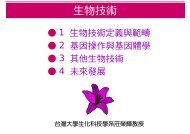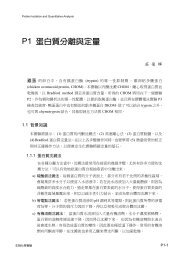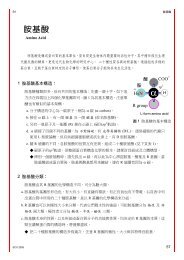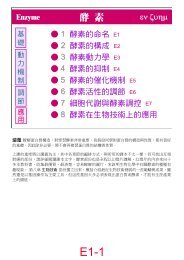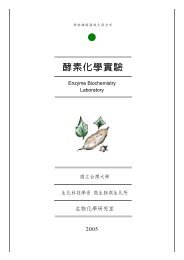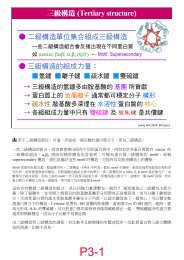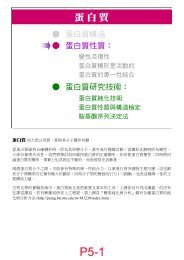Two dimensional electrophoresis, Sample preparation
Two dimensional electrophoresis, Sample preparation
Two dimensional electrophoresis, Sample preparation
You also want an ePaper? Increase the reach of your titles
YUMPU automatically turns print PDFs into web optimized ePapers that Google loves.
<strong>Two</strong> <strong>dimensional</strong> <strong>electrophoresis</strong>,<strong>Sample</strong> <strong>preparation</strong>美 和 技 術 學 院吳 裕 仁 助 理 教 授<strong>Two</strong> <strong>dimensional</strong> <strong>electrophoresis</strong>Only “Proteomics” is the large-scale screening of theproteins of a cell, organism or biological fluid, a processwhich requires stringently controlled steps of sample<strong>preparation</strong>, 2-D <strong>electrophoresis</strong>, image detection andanalysis, spot identification, and database searches.The core technology of proteomics is 2-DEAt present, there is no other technique that is capable ofsimultaneously resolving thousands of proteins in oneseparation procedure. (sited in 2000)
Evolution of 2-DE methodologyTraditional IEF procedure:IEF in run in thin polyacrylamide gel rods in glass orplastic tubes.Gel rods containing:1. urea 2. detergent 3. reductant4. carrier ampholytes (form pH gradient).Problem: 1. tedious. 2. not reproducible.In the pastEvolution of 2-DE methodologySDS-PAGE Gel Size:This “O’Farrell” techniques has been used for 20 yearswithout major modification.20 x 20 cm have become a standard for 2-DE.Assumption: 100 bands can be resolved by 20 cm long1-DE.Therefore, 20 x 20 cm gel can resolved 100 x 100 =10,000 proteins, in theory. 100100
Evolution of 2DE methodologyProblems with traditional 1 st dimension IEFWorks well for native protein, not good for denaturingproteins, because:1. Takes longer time to run.2. Techniques are cumbersome. (the soft, thin, long gel rodsneeds excellent experiment technique)3. Patterns are not reproducible enough.4. Lost of most basic proteins and some acidic protein.Evolution of 2-DE methodologyResolution for IEF: Immobilized pH gradients.Developed by Bjellqvist (1982, Biochem. Biophys Methods, vol 6, p317)pH gradient are prepared by co-polymerizing acrylamidemonomers with acrylamide derivatives containingcarboxylic and tertiary amino groups.1. The pH gradient is fixed, not affected by sample composition.2. Reproducible data are presented.3. Modified by Angelika Gorg by using thin film to support the thinpolyacrylamide IEF gel, named Strips. (1988, Electrophoresis, vol 9, p531)
II. Immobilized pH gradient, IPGFirst developed by Righetti ,(1990).Immobilized pH gradient generated by bufferingacrylamide derivatives (Immobilines)Immobilines are weak acid or weak base.General structureCH 2CNCNRCH 2CNCNHOHOHR = amino or carboxylic groupsAcrylamideSchematic drawing of a IPG
Run 2-DE, a quick overviewTodays 2-DEOnly high-resolution 2-DE with both dimensionsrun under denaturing conditions is used.Goal: to separate and display all gene productspresent.
Challenges for 2-DE1. Spot number:– 10,000-150,000 gene products in a cell.– PTM makes it difficult to predict real number.– Sensitivity and dynamic range of 2-DE must beadquete.– It’s impossible to display all proteins in one single gels.Challenges for 2-DE2. Isoelectric point spectrum:– pI of proteins: range from pH 3-13. (by in vitrotranslated ORF)– PTM would not alter the pI outside this range.– pH gradient from 3-13 dose not exist.– For proteins which pI > 11.5, they need to be handedseparately.
Challenges for 2-DE5. Sensitivity of detection:Low copy number proteins are very difficult to detect,even employing most sensitive staining methods.– Sensitivity of staining methods:1. Silver staining2. Fluorescent staining3. Dye binding staining (CBR)4. Znic stainChallenges for 2-DE6. Loading capacity:– For detection of low abundant proteins, moresample needs to be loaded.– A wide dynamic range of the SDS-PAGE isrequired to prevent merging of highly abundantprotein.– Loading capacity: IEF > SDS-PAGE.
Challenges for 2-DE7. Quantitation:– The detection method must give reliablequantitative information.– Silver staining does not give reliable quantitativedata.<strong>Sample</strong> <strong>preparation</strong>
Some important concepts for sample <strong>preparation</strong>1. A good sample <strong>preparation</strong> is the key to good result.2. The protein composition of the cell lysate or tissue mustbe reflected in the patterns of 2-DE.3. Avoid protein contamination from environment.4. Co-analytical modification (CAM) must be avoided.(pre-purification sometimes leads to CAM)Some important concepts for sample <strong>preparation</strong>5. Treatment of sample must be kept to a minimum toavoid sample loss.• Keep sample as cold as possible.• Shorten processing time as short as possible.• Removal of salts• Minimized the unwanted processing, proteolyticdegradation, chemical modification.
Frequently applied treatments1. Cell washing2. Cell disruption3. Removal of contaminant4. Microdialysis5. Precipitation methodsCell WashingTo remove contaminant material.Frequent used buffer– PBS: phosphate buffer saline, sodium chloride, 145mM (0.85%) in phosphate buffer, 150 mM pH7.2– Tris /sucrose buffer (10mM Tris, 250 mM sucrose,pH 7,2)Enough osmotic to avoid cell lysis
Cell disruption– Gentle lysis method1. Osmotic lysis (cultured cells)– Suspend cells in hypoosmotic solution.2. Repeated freezing and thawing (bacteria)– Freeze using liquid nitrogen3. Detergent lysis (yeast and fungi)– Lysis buffer (containing urea and detergent)– SDS (have to be removed before IEF)4. Enzymatic lysis (plant, bacteria, fungi)– Lysomzyme (bacteria)– Cellulose and pectinase (plant)– Lyticase (yeast)Cell disruption– Vigorous lysis method1. Sonication (cell suspension)– Avoid overheat, cool on ice between burst.2. French pressure (microorganism with cell wall)– Cells are lysed by shear force.3. Mortar and pestle (solid tissue, microorganism)– Grind solid tissue to fine powder with liquid nitrogen.4. <strong>Sample</strong> grinding kit (for small amount of sample)– For precious sample.5. Glass bead (cell suspension, microorganism)– Using abrasive vortexed bead to break cell walls.
Removal of contaminants– Major type of contaminants:1. DNA/RNA2. Lipids3. polysaccharides4. Solid material5. SaltDNA/RNA contaminant– DNA/RNA can be stained by silver staining.– They cause horizontal streaking at the acidic part ofthe gel.– They precipitate with the proteins when sampleapplying at basic end of IEF gel– How to remove:1. precipitation of proteins2. DNase/RNase treatment3. sonication (mechanical breakage)4. DNA/RNA extraction method(phenol/chroloform)
Contaminants that affect 2-D ResultContaminants Reason for removal Removal techniques鹽 、 殘 留 buffer 或 是 樣品 沉 澱 時 一 直 存 在 的 帶電 小 分 子內 生 性 小 離 子 分 子 ( 如 核酸 、 代 謝 物 、 磷 脂 質 等 )Polysaccharide1. 在 電 泳 過 程 中 鹽 必 須 被 去除 , 若 有 存 在 也 要 濃 度 越小 越 好 。2. 鹽 若 是 存 在 於 IEF 電 泳 系統 中 , 會 使 的 strip 造 成 高傳 導 性 , 聚 焦 的 現 象 不 容易 發 生 。內 生 性 小 離 子 分 子 存 在 於 各種 cell lysate。 這 種 物 質 通常 是 帶 負 電 性 造 成 通 往 陽 極方 向 不 易 聚 焦 。Polysaccharide 會 阻 塞 住 膠體 , 也 會 影 響 沉 澱 及 聚 焦 。脫 鹽 的 方 法1. 透 析2.spin 透 析3. 膠 體 過 濾4. 沉 澱 或 是 重 新 懸 浮TCA/acetone 沉 澱 是 最 容 易去 除 這 些 污 染 物 的 方 法 , 上述 去 鹽 方 法 也 適 用 。1. 利 用 TCA、 硫 酸 銨 或 醋 酸銨 / 甲 醇 /phenol 沉 澱 法 可以 去 除 。2. 超 高 速 離 心 可 以 去 除 高 分子 量 的 醣 類 。Contaminants that affect 2-D ResultContaminants Reason for removal Removal techniques核 酸 (DNA, RNA)Lipid1. 過 量 的 核 酸 會 使 得 樣 品 增加 黏 稠 度 而 且 會 有 背 景 呈色 。2. 高 分 子 量 的 核 酸 會 造 成 膠體 堵 塞 。3. 核 酸 會 造 成 蛋 白 質 不 易 聚焦 。容 易 造 成 蛋 白 質 不 易 溶 解 且會 影 響 到 其 pI 及 分 子 量 。1. 若 樣 品 中 含 有 高 量 核 酸時 , 利 用 protease-freeDnase/Rnase 減 低 核 酸2. 超 高 速 離 心 可 以 去 除 高 分子 量 的 核 酸 。利 用 acetone 沉 澱 可 以 去 除lipid 的 干 擾 。離 子 清 潔 劑 SDS 會 使 蛋 白 質 帶 負 電 ,使 蛋 白 質 不 能 聚 焦 。1. 丙 酮 沉 澱 可 以 部 分 的 去 除SDS 。2. 將 具 有 SDS 的 蛋 白 質 溶於 含 有 兩 性 或 者 是 非 離 子之 detergent 如CHAPS,Triton X-100 或NP-40 的 buffer, 使 得SDS 最 終 濃 度 小 於 0.25%。
Precipitation methods.– The reasons for applying protein precipitationprocedure:1. Concentrate low concentrated protein samples.2. Removal of several disturbing material at thesame time.3. Inhibition of protease activity.Five precipitation methods.1. Ammonium sulfate precipitation2. TCA precipitation3. Acetone precipitation4. TCA/Acetone precipitation5. Ammonium acetate/ methanol / phenolextraction
沉 澱 蛋 白 質 方 法硫 酸 銨 沉 澱 法( 在 高 鹽 濃 度 下 , 蛋 白 質 可 能 會 沉 澱或 聚 集 , 許 多 雜 質 如 nucleic acid仍 然 會 在 溶 液 中 )TCA 沉 澱 法( 對 於 蛋 白 質 沉 澱 非 常 有 效 率 )丙 酮 沉 澱 法( 這 種 有 機 的 蛋 白 質 沉 澱 法 時 常 被 使用 )優 缺 點1. 許 多 蛋 白 質 仍 然 溶 解 於 高 鹽 濃度 的 環 境 中 , 這 種 方 法 對 於 要看 全 部 蛋 白 質 的 實 驗 較 不 適 合2. 若 要 使 用 此 方 法 可 以 事 先 分 餾或 濃 縮 。3. 殘 留 的 硫 酸 銨 會 影 響 IEF 的 進行1. 蛋 白 質 可 能 很 難 以 去 溶 解 或 是溶 解 不 完 全 。2.pH 值 太 低 可 能 會 造 成 蛋 白 質 分解 或 是 被 修 飾1. 蛋 白 質 可 能 很 難 以 去 溶 解 或 是溶 解 不 完 全2. lipid 或 detergent 等 物 質 仍 然會 溶 在 溶 液沉 澱 蛋 白 質 方 法TCA/ 丙 酮 沉 澱 法( 利 用 TCA/ 丙 酮 沉 澱 法 製 備 蛋 白 質在 2DE 電 泳 上 最 常 被 使 用 )醋 酸 銨 / 甲 醇 /phenol 沉 澱 法( 這 種 方 法 適 用 於 處 理 植 物 樣 品 , 且樣 品 中 具 有 高 量 的 雜 質 )優 缺 點1. 蛋 白 質 可 能 很 難 以 去 溶 解 或 是 溶解 不 完 全2.pH 值 太 低 可 能 會 造 成 蛋 白 質 分 解或 是 被 修 飾 。這 種 方 法 耗 時 又 複 雜
For very hydrophobic proteinsMembrane proteins do not easily go intosolution. A lot of optimization work is required.Thiourea procedureSDS procedureNew zwitterionic detergent and sulfobetains2-DE instruments, 1st dimensionAmersham BiosciencesBio-Rad
2-DE instruments, 2nd dimensionAmersham Biosciences23 x 20 cm8 x 10 cm16 x 16 cm2-DE instruments, 2nd dimensionBio-Rad
進 行 IEF 的 方 法1.Strip holder2.Loading sample 至 strip holder 中3. 撕 開 strip 膠 面 朝 下4. 撕 開 strip 膠 面 朝 下進 行 IEF 的 方 法5. 將 strip 放 入 strip holder 中 6. 將 strip 放 入 strip holder 中7. 趕 走 膠 面 下 的 氣 泡 8. 加 入 cover oil
進 行 IEF 的 方 法9. 蓋 上 strip holder 蓋 子10. 將 strip holder 放 入 IPGphorRehydration solution volume per immobiline DryStripIPG strip length (cm)Total volume per strip (μl)7 cm 125 μl11 cm 200 μl13 cm 250 μl18 cm 340 μl24 cm 450 μl
SDS 膠 片 鑄 膠1. 將 spacer 放 置 於 玻 璃 片 上3. 將 spacer 和 玻 璃 片 組 合 起 來3. 將 玻 璃 片 至 於 膠 片 固 定 器 上 4. 將 spacer 靠 旁 邊 推 緊SDS 膠 片 鑄 膠5. 將 膠 片 固 定 器 鎖 緊 6. 將 其 放 至 於 鑄 膠 器 上7. 以 二 次 水 進 行 測 漏
平 衡 IEF Gel 方 法1. 倒 入 平 衡 緩 衝 液 A (DTT) 2. 將 strip 放 入 平 衡 槽 中3. 倒 入 平 衡 緩 衝 液 B (IAA) 4. 再 將 strip 放 入 平 衡 槽 中Components of the equilbilum bufferUrea ( 6M )GlycerolSDSDTTIodoacetamideTogether with glycerol reduces the effects ofelectroendosmosis by increasing the viscosity ofthe bufferReduces the effects of electroendosmosis andimproves transfer of protein from the first to thesecond-dimensionDenatures proteins and forms negativelycharged protein-SDS complexes.Preserves the fully reduced state of denatured,unalkylated proteinsAlkylates thiol groups on proteins, preventingtheir reoxidantion during <strong>electrophoresis</strong>
製 備 marker 方 法1. 濾 紙 片 中 加 入 marker 2. 封 上 一 層 agarose3. 待 agarose 乾 後 以 刮 勺 割 下 4. 放 入 SDS 電 泳 膠 片 上製 備 marker 方 法5. 放 入 SDS 電 泳 膠 片 上
進 行 SDS PAGE 方 法1. 取 SDS buffer2. 將 SDS buffer 到 入 膠 體 上3. 放 入 strip 4. 以 藥 勺 將 strip 壓 平進 行 SDS PAGE 方 法5. 封 上 一 層 agarose 6. 架 上 上 層 電 泳 槽7. 放 入 Ruby 電 泳 槽 中 8. 以 200 V 進 行 電 泳 分 析
拆 除 膠 片 及 染 色1. 旋 開 固 定 器 2. 以 刀 片 將 一 邊 spacer 推 開3. 利 用 spacer 將 玻 璃 片 橇 開 4. 將 玻 璃 片 拿 起拆 除 膠 片 及 染 色5. 將 膠 片 輕 輕 捲 起 放 入 染 缸 中6. 倒 入 CBR 染 劑
Now, we are ready to dissolve protein samplesin IEF sample buffer (lysis buffer)What is the compositionin IEF sample buffer?Components of the sample bufferUreaDetergentSolubilizes and denatures proteins.Thiourea can improve protein solubilization.CHAPS, Triton X-100, or NP-40Solubilize hydrophobic proteins and minimizesprotein aggregationIPG buffer pH 3-10, pH 4-7, pH 6-11Ampholyte mixtures enhance protein solubilityand produce more uniform conductivityReductant DTT or DTE ( 20 to 100 mM )Cleavage disulfide bonds to allow proteins tounfold completely
Composition of standard sample buffer (for IEF)1. Urea2. CHAPS3. DTT4. Ampholyte5. bromophenol blue.1352Functions of denaturant (Urea)1. To convert proteins into single conformation bycanceling 2 nd and 3 rd structure.2. To keep hydrophobic proteins into solution.3. To avoid protein-protein interaction.4. Thiourea: for very hydrophobic proteins only.Thiourea
Beware when using urea1. The purity of urea is very critical2. Isocyanate impurities and heating will causecarbamylation of the proteins.3. It does not seem to make a difference what grade ofurea is used because, urea + heat + protein =carbamylation.Carbamylation of proteins
Results of CarbamylationAmino AcidResidueCompositionResidueMonoisotopicMassDeltaMassLysine C 6 H 12 N 2 O 128.09496 0CarbamylLysineC 7 H 13 N 3 O 2 171.10078 43.00582Carbamylation * NHCO 43.00582 -*Note: A proton is lost from the amino group on the protein duringcarbamylation and thus the change in composition is NHCO.Functions of detergent (CHAPS)superior membrane protein solubilization propertiesNon-denaturingAble to disrupt nonspecific protein interactionsLess protein aggregation than non-ionic detergentsEasily removed by dialysis
Functions of reductantTo prevent different oxidation steps of proteins.2-mercaptoethanol should not be used because itsbuffering effect above pH 8.Keratin contamination might from 2-mercaptoethanol.DTT (dithiothreitol) or DTE (dithioerythritol) are usedwidely.It leads to horizonal streaking at basic area.Function of carrier ampholyteThey do not disturb IEF like buffer addition, because theybecome uncharged when migrating to their pI.1. To generate pH gradients2. To substituting ionic buffer3. To improve the solubility of protein4. Dedicated pH intervals, prepared for the addition toimmobilized pH gradients, are called IPG buffer.
Function of dyesTo visualize the sample solutionTo monitor the 2-DE running condition.Bromophenol blue is interchangeable with Orange G.+ -不 同 抽 取 方 法 會 呈 現 不 同 的 結 果A B CA: 竹 筍 水 溶 性 蛋 白 質 B: 竹 筍 非 水 溶 性 蛋 白 質 C: 竹 筍 醣 蛋 白 質
竹 筍 出 土 前 後 非 水 溶 性 蛋 白 表 現 確 有 差 異未 出 土60 cm13 cm strip, 12.5% SDS PAGE, pH 4-7竹 筍 出 土 前 後 醣 蛋 白 表 現 確 有 差 異未 出 土60 cm13 cm strip, 15% SDS PAGE, pH 4-7
竹 筍 出 土 前 後 水 溶 性 蛋 白 表 現 確 有 差 異未 出 土60 cm13 cm strip, 12.5% SDS PAGE, pH 4-713 cm strip, 12.5% SDS PAGE, pH 3-10
13 cm strip, 12.5% SDS PAGE, pH 7-10水 溶 性 蛋 白 質 — 螢 光 標 定 法無 性 芽 水 溶 性 蛋 白 質 Cy5 花 芽 水 溶 性 蛋 白 質 Cy34 713 cm, 12.5% SDS-PAGE, Cy3 and Cy5
硝 酸 銀 染 色CBR 染 色SDS 膠 體 鑄 膠 不 完 全 所 造 成IEF 沒 有 聚 焦 成 功
膠 片 轉 印 方 法1. 倒 入 甲 醇 2. 放 入 濾 紙3. 放 入 PVDF 4. 放 入 膠 片膠 片 轉 印 方 法5. 放 入 膠 片 6. 蓋 上 濾 紙8. 蓋 上 轉 印 夾8. 將 轉 印 夾 放 進 轉 印 槽 中
N 端 定 序膠 片 轉 印 後 以 CBR 呈 色免 疫 染 色 流 程膠 體 轉 印 至 PVDF 膜以 urea-PBST 清 洗以 PBST 清 洗 2~3 次加 入 1 次 抗 體 1hrmAb or polyclone Ab家以 PBST 清 洗 2~3 次加 入 2 次 抗 體 1hr以 PBST 清 洗 2~3 次DAB 呈 色ECL 呈 色
免 疫 染 色 結 果化 學 冷 光 呈 色 (ECL)DAB 呈 色




